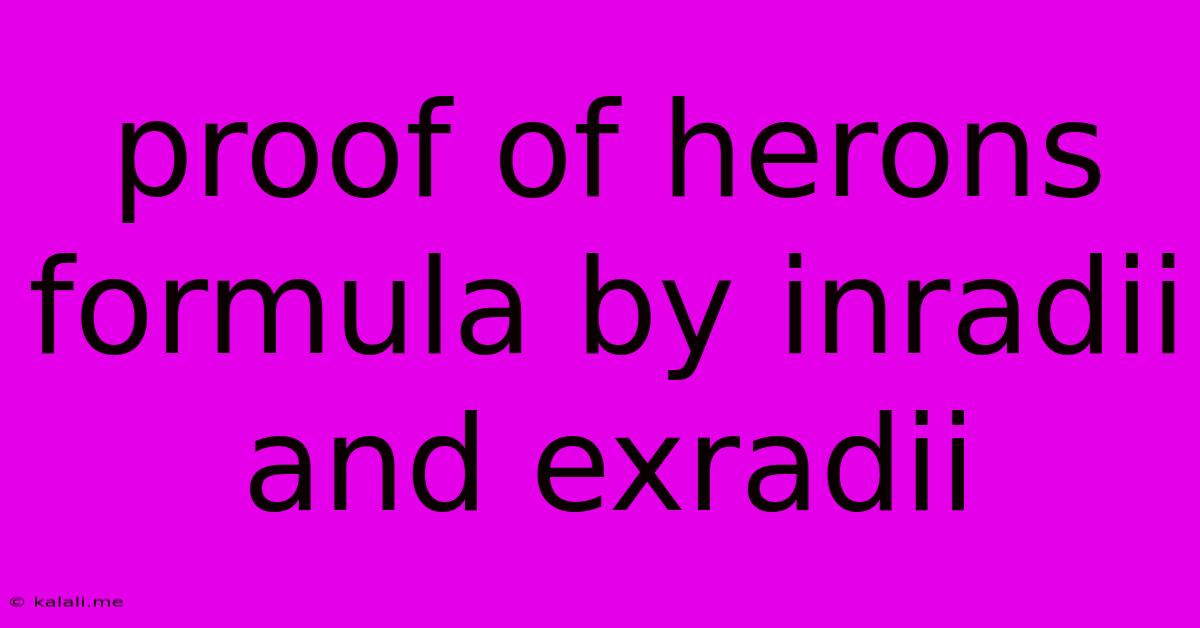Proof Of Herons Formula By Inradii And Exradii
Kalali
May 24, 2025 · 3 min read

Table of Contents
Heron's Formula: A Proof Using Inradii and Exradii
Heron's formula provides a remarkably elegant way to calculate the area of a triangle given only the lengths of its three sides. While the formula itself is relatively straightforward, its proof can be approached in several ways. This article presents a compelling proof using the inradius and exradii of the triangle. This method offers a deeper understanding of the relationship between a triangle's area, its sides, and its inscribed and escribed circles.
Understanding the Key Components:
Before diving into the proof, let's define the key terms:
-
Heron's Formula: The area (A) of a triangle with sides a, b, and c is given by: A = √[s(s-a)(s-b)(s-c)], where s = (a+b+c)/2 is the semi-perimeter.
-
Inradius (r): The radius of the circle inscribed within the triangle (incircle). This circle is tangent to all three sides of the triangle.
-
Exradii (r<sub>a</sub>, r<sub>b</sub>, r<sub>c</sub>): The radii of the three circles that are tangent to one side of the triangle and the extensions of the other two sides (excircles). Each excircle is tangent to one side and the extensions of the other two sides.
The Proof:
We'll begin by expressing the area of the triangle in terms of its inradius and semi-perimeter:
- Area (A) = rs, where r is the inradius and s is the semi-perimeter.
Next, we'll utilize the relationship between the area and the exradii:
- Area (A) = (s-a)r<sub>a</sub> = (s-b)r<sub>b</sub> = (s-c)r<sub>c</sub>
Now, let's consider the product of the area expressed through the inradius and the three expressions using exradii:
A⁴ = (rs)³(s-a)r<sub>a</sub>(s-b)r<sub>b</sub>(s-c)r<sub>c</sub>
We know that the product of the inradius and the three exradii is related to the area by the equation:
r * r<sub>a</sub> * r<sub>b</sub> * r<sub>c</sub> = A²
Substituting this into our equation, we get:
A⁴ = (rs)³A²
Simplifying, we have:
A² = (rs)²
A = rs
This demonstrates that the area of a triangle can be expressed as the product of the inradius and semi-perimeter.
Now, we need to connect this back to Heron's formula. This involves utilizing the following relationship, which can be proven through geometric arguments involving the areas of smaller triangles formed by the incenter and vertices:
r = √[(s-a)(s-b)(s-c)/s]
Substituting this expression for r into A = rs, we obtain:
A = s * √[(s-a)(s-b)(s-c)/s]
Simplifying, we arrive at Heron's formula:
A = √[s(s-a)(s-b)(s-c)]
Therefore, we've successfully proven Heron's formula using the inradius and exradii of the triangle. This method provides a richer understanding of the underlying geometric relationships involved in calculating a triangle's area. This elegant proof highlights the power of combining geometric insights with algebraic manipulations.
Latest Posts
Latest Posts
-
Can Youo Mate With A Knight And Kings
May 24, 2025
-
Bash Remove Last Character From String
May 24, 2025
-
Why Is My Fuse Box Chirping
May 24, 2025
-
How To Factory Reset Rca Tablet
May 24, 2025
-
20 Amp Switch On 15 Amp Circuit
May 24, 2025
Related Post
Thank you for visiting our website which covers about Proof Of Herons Formula By Inradii And Exradii . We hope the information provided has been useful to you. Feel free to contact us if you have any questions or need further assistance. See you next time and don't miss to bookmark.